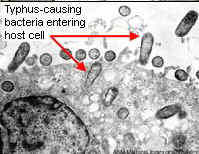 Typhus fever
Typhus fever
Introduction.
There are 3 clinical forms of typhus fever: epidemic, endemic, and scrub typhus; none are to be confused with typoid fever (Salmonella). Epidemic typhus fever is caused by the highly infectious Rickettsia prowazekii and is common in Africa and South America. Epidemic typhus fever has a human reservoir and is transmitted by the human body louse. Endemic typhus, present on most continents but less so in the US, is caused by R. typhi is a zoonotic disease (rodent reservoir) transmitted by fleas, and scrub typhus (Orientia tsutsugamushi) is a zoonotic disease carried in and transmitted by mites. It is most common in Asia and Australia. Rickettsialpox is caused by R. akari and is seen in metropolitan areas (rodent reservoir, mite vector) and includes formation of an eschar at the bite site which resembles cutaneous anthrax. A generalized pox-like rash follows later.
Summary
Epidemic typhus
- Cause: Rickettsia prowazekii
- Microscopy: Gram-negative bacilli; tiny; intracellular
- Transmission: Human-to-human via body lice (vector)
- Symptoms: fever, chills, headache, myalgia, rash in <40%
- Complications: myocarditis, CNS dysfunction, high mortality if untreated
- Pathogenesis: Intracellular replication in vascular endothelium
- Treatment: tetracycline, chloramphenicol
Endemic typhus
- Cause: Rickettsia typhi
- Microscopy: Gram-negative bacilli; tiny; intracellular
- Transmission: zoonotic (rodents) via fleas (vector)
- Symptoms: fever, headache, myalgia, cough, rash in > 55%
- Pathogenesis: Intracellular replication in vascular endothelium
- Treatment: tetracycline, chloramphenicol, doxycycline
Scrub typhus
- Cause: Orientia tsutsugamushi
- Microscopy: Gram-negative bacilli; tiny; intracellular
- Transmission: zoonotic (mites = vector)
- Symptoms: fever, severe headache, myalgia, rash in < 50%
- Complications: spleen enlargement, CNS complications, heart failure
- Pathogenesis: Intracellular replication
- Treatment: tetracycline, chloramphenicol, doxycycline
Rickettsialpox
- Cause: Rickettsia akari
- Microscopy: Gram-negative bacilli; tiny; intracellular
- Transmission: zoonotic (rodents) via mites (vector)
- Symptoms: Papule/eschar at bite site; fever, headache, myalgia, chills & sweats, papulovesicular rash, crusts over (pox-like)
- Pathogenesis: Intracellular replication
- Treatment: untreated: 2-3 week recovery; less time with doxycycline
Rickettsia parkeri rickettsiosis
- Cause: Rickettsia parkeri
- Microscopy: Gram-negative bacilli; tiny; intracellular
- Transmission: zoonotic (rodents) via ticks (vector): southeastern US
- Symptoms: Papule/eschar at bite site; fever, headache, myalgia
- Pathogenesis: Intracellular replication
- Treatment: untreated: 2-3 week recovery; less time with doxycycline
Pacific Coast tick fever (PCTF)
- Cause: Rickettsia philipi (strain 364D)
- Microscopy: Gram-negative bacilli; tiny; intracellular
- Transmission: zoonotic (rodents) via ticks (vector) in Oregon - California
- Symptoms: Papule/eschar at bite site; fever, headache, myalgia
- Pathogenesis: Intracellular replication
- Treatment: untreated: 2-3 week recovery; less time with doxycycline